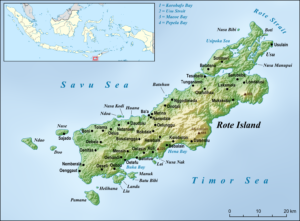
In an article to be published soon in Popular Archaeology Magazine, mariner-explorer and writer/historian Robert Hobman narrates in his own words his plans to traverse the waters of the Timor Sea from Indonesia to the coast of Australia in a sea-going vessel, or raft, fashioned according to what he and his team suggest was the technology available to prehistoric mariners tens of thousands of years ago.
Planned for February of 2020, the vessel will begin on Rote Island, an island of Indonesia and part of the East Nusa Tenggara province of the Lesser Sunda Islands. Rote lies 500 km (311 mi) northwest of the Australian coast and southwest of the larger island of Timor. To Rote’s immediate south is the Timor Sea, which is bounded in the north by the island of Timor, the east by the Arafura Sea, and the south by Australia.
Hobman hopes to replicate as much as possible the voyage he suggests ancient Pleistocene mariners made from Indonesia—which is part of the continent of Eurasia—to Australia, one of the first landforms of Oceania as one goes eastward.
“By at least 65,000 BC, so the latest archaeological clues tell us,” writes Hobman in the article, Homo sapiens “had discovered what is today known as Australia and began colonizing it. By 30,000 BC, according to the archaeological record, they had settled all the islands of Wallacea, the Philippines, and Melanesia of the Western Pacific……It is our hypothesis that these ancient ‘Wallaceans’ – there seems to be no contradicting theory – are the ancestors of the Melanesians and all the indigenous inhabitants of Sahul Land, the vast combined landmass of Papua New Guinea, Australia and Tasmania before the polar ice melted and the sea rose to terrestrially separate them.”
The raft will be constructed of locally available (and thought to have been available there in Pleistocene times) materials, such as bamboo, using stones tools and technology thought to have likely been used or at least available at the time. Food preparation and foodstuffs for the voyage will also be employed based on what the team suggests was likely in the area during prehistoric times.
“It will not be a drift voyage. Nor will it be a sailing venture, but something in between,” writes Hobman. “The raft’s crew will have paddles but also a great pile of palm leaves. As the first human conquerors of the Timor Sea would have done, some kind of basic sail must have been employed.”
Hobman believes that we have probably underestimated the capabilities and resolve of our prehistoric ancestors. “Humans are notoriously adept at exploiting nature to ease their burden,” he maintains. “…..even the earliest hominins were not stupid or suicidal enough to treat the oceans and enclosed seas……with anything but caution and a great deal of respect.”
His article will be available as a free premium article in the Winter 2019 Issue of Popular Archaeology Magazine.
_________________________________

Map of Rote Island, from which Hobman and his crew will embark. Lencer, Wikimedia Commons
_________________________________
See, first-hand, the original fossils. See original artifacts. See the actual sites. Talk with the famous scientists. Join us on this unique specialized study tour.




